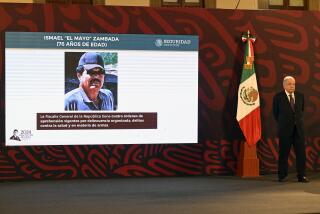Diplomat Says He Told U.S. Where Noriega Was Hiding : Panama: The military command responded that it had other priorities during initial attack, he says.
- Share via
PANAMA CITY — Less than three hours after U.S. troops began their invasion here Dec. 20, American officials were told where fugitive Panamanian dictator Manuel A. Noriega was hiding but disregarded the information, according to a European diplomat who made the call.
“In the third hour of the attack,” the diplomat said, “he was two houses down (from the diplomat’s home), in the flat of Vicki’s grandmother” in a high-rise structure called Edificio Winston Churchill. The diplomat referred to Vicki Amado, known to have been Noriega’s mistress, and said he was “100% certain” of the ousted general’s location.
“But when I called,” the diplomat continued, “SouthCom (the U.S. Southern military command) said it had other priorities.”
In fact, the diplomat said, he was fairly certain that Noriega had been in Amado’s own apartment when the invasion began at 1 a.m. or that he had arrived shortly afterward. The diplomat lives in the Bahia Mar apartment building, where Amado had moved into a sixth-floor flat a week earlier from Edificio Winston Churchill.
The diplomat, who has served here for several years and had met several times with both Noriega and Amado, said there was no doubt that the general had been in the Winston Churchill building between 3 a.m. and 4 a.m. on Dec. 20.
Not only was he seen there, but other residents also reported that Noriega’s black Mercedes-Benz sedan had been parked at both the Bahia Mar and the Winston Churchill during the early hours of the fighting.
They also confirmed the diplomat’s assertion, adding that Noriega’s well-known bodyguards were present in both structures between 2 a.m. and 4 a.m.
Southern Command officials did not return several calls about the diplomat’s statements, and there was no comment from the U.S. Embassy.
Noriega’s capture was one of the main goals of the invading troops, who had been told that he was spending the night in his official military headquarters, a sprawling complex in the middle of a low-income neighborhood called Chorrillo.
However, the strongman was not there. In fact, he seldom slept in the Comandancia, as the headquarters were called, and reportedly changed locations four or five times on any given night to thwart any kidnaping attempt.
But the diplomat and other residents of the Bahia Mar and Winston Churchill apartment houses said he visited one or the other of the two buildings several days each week, a pattern well-known in the neighborhood.
“It was one big U.S. blunder,” the diplomat declared, adding that the blunder was compounded by American officials as they continued searching for Noriega before he found more than a week of temporary refuge in the Vatican embassy, less than 200 yards from the two apartment buildings.
“During the period he was at large, and even after he had entered the Vatican embassy, the Americans never thought to tap (Vicki Amado’s) phones,” said the diplomat, thus missing both a probable opportunity to trace the fugitive and to obtain valuable intelligence.
In fact, he said, “it wasn’t until one of the government’s vice presidents (Ricardo Arias Calderon or Guillermo Ford) suggested (it) that Vicki was (seen as) the best way to get to Noriega”
Still, it was not until last Sunday that Amado was arrested. “At 2 a.m.,” he said, “20 or 30 Americans, including MPs, came and took her away. They could have had her on the first day . . . and the American Embassy was told.” She remains in U.S. custody while the Panamanians consider charges against her involving alleged corruption.
The mishandling of the situation still hadn’t ended, the diplomat said, adding, “It was only (Wednesday) that Panamanian officials came and raided the Amado family’s residences here” and at the Winston Churchill.
The diplomat, who represents a major U.S. ally and has extremely close contacts with the Vatican embassy, recounted what he characterized as other lapses in American intelligence and actions in dealing with Noriega.
Although he said the papal nuncio, Archbishop Jose Sebastian Laboa, did not inform U.S. officials that Noriega had called and was planning to enter the embassy Dec. 24, Laboa did try to phone Maj. Gen. Marc Cisneros, commander of U.S. Army South, after the dictator arrived.
“Laboa called for nearly an hour and a half, but only got busy signals,” said the envoy, who was in the embassy at the time.
The diplomat, who visited the Vatican mission nearly every day during Noriega’s stay and acted as an unofficial adviser and consultant to Laboa during the crisis, said the ambassador had expected the general to show up.
“The Vatican embassy was the only place he (Noriega) could be sure nothing would happen to him,” the diplomat said. “Any other place would have been stormed.”
In that light, he said, both he and Laboa were surprised that U.S. troops had not sealed off the Vatican mission, as they had other likely refuges such as the Cuban and Nicaraguan embassies.
U.S. officials said originally that they did not seal off the Vatican embassy as part of a conscious policy to provide Noriega with an incentive to do exactly as he did. Later, however, they said they did not put the Vatican embassy under surveillance simply because they did not have the forces at a time when American troops were still fighting Noriega supporters and trying to secure other parts of the city.
More to Read
Sign up for Essential California
The most important California stories and recommendations in your inbox every morning.
You may occasionally receive promotional content from the Los Angeles Times.













